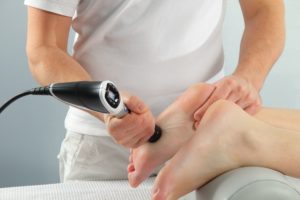Are you suffering from plantar fasciitis and looking for a way to find relief? Shockwave therapy may be the answer. Shockwave therapy is a non-invasive, drug-free treatment that can help reduce heel pain and inflammation associated with plantar fasciitis. It is available to those looking for a safe and effective treatment option for their condition. In this blog post, we’ll look at the benefits and how it can help you step into recovery.
Understanding Plantar Fasciitis
Understanding Plantar Fasciitis is key to finding effective treatment options. Plantar Fasciitis is a common foot condition characterized by inflammation and irritation of the plantar fascia, a thick band of tissue that connects the heel bone to the toes. This condition can cause intense heel pain and discomfort, making it difficult to walk or stand for long periods. If left untreated, it can lead to chronic foot problems. Thankfully, it can help alleviate the symptoms and promote healing.
Traditional Treatments for Plantar Fasciitis
When it comes to traditional treatments for plantar fasciitis, there are several options available. These include rest and ice, stretching exercises, orthotic inserts, physical therapy, and anti-inflammatory medications. However, while these treatments may provide some relief, they often only address the symptoms and not the underlying cause of the condition. Unlike traditional treatments, Shockwave therapy targets the root cause of plantar fasciitis, promoting healing and long-term relief. So, if you’ve tried other methods without success, it may be time to consider this innovative treatment option.
What is Shockwave Therapy and How Does It Work?
Shockwave therapy is a non-invasive treatment that uses high-energy sound waves to stimulate the body’s natural healing processes. It works by targeting the affected area, such as the plantar fascia, and increasing blood flow, promoting tissue regeneration, and reducing inflammation. The shockwaves help to break down scar tissue and stimulate the release of healing factors, providing relief from conditions like plantar fasciitis, tendonitis, knee pain, shoulder pain, and tennis elbow. This innovative therapy offers a safe and effective solution for those seeking long-term relief from chronic pain.
The Benefits of Shockwave Therapy for Plantar Fasciitis
Shockwave therapy offers a multitude of benefits for those suffering from plantar fasciitis. This non-invasive treatment not only provides relief from heel pain and inflammation but also promotes tissue regeneration and reduces scar tissue. In addition to treating plantar fasciitis, shockwave therapy can also effectively address conditions such as tendonitis, knee pain, shoulder pain, and tennis elbow. With its ability to target the root cause of the problem and stimulate the body’s natural healing processes, shockwave therapy is a game-changer in the realm of pain management.
What to Expect During a Shockwave Therapy Session
During a session for plantar fasciitis, you can expect a comfortable and non-invasive experience. Your healthcare provider will use a handheld device, such as EPAT, to deliver shockwaves to the affected area. These shockwaves may feel like mild pulses or vibrations, some aches while treating is normal. The session typically lasts around 10-15 minutes, and multiple sessions may be required for optimal results. It’s important to communicate any discomfort or concerns with your provider, who will ensure your comfort and safety throughout the treatment.
Recovery and Results After Shockwave Therapy
After undergoing shockwave therapy for plantar fasciitis, patients can expect to experience significant improvement in their symptoms. The therapy stimulates tissue regeneration and reduces scar tissue, leading to reduced heel pain and inflammation. Patients may need multiple sessions for optimal results, but the treatment is comfortable and non-invasive. EPAT, a handheld device, delivers mild pulses or vibrations to the affected area. Overall, recovery and results after offer hope for those seeking long-term relief from plantar fasciitis.
Potential Risks and Side Effects of Shockwave Therapy
While shockwave therapy is generally considered safe, it is important to be aware of the potential risks and side effects. Some individuals may experience temporary discomfort or pain during the treatment, but this is typically mild and short-lived. In rare cases, bruising, swelling, or skin redness may occur at the treatment site. It is also important to note that shockwave therapy is not recommended for individuals with certain medical conditions, such as blood clotting disorders or pregnancy.
Who is a Candidate for Shockwave Therapy?
Are you suffering from chronic plantar fasciitis? Shockwave therapy may be the answer for you. This non-invasive treatment is suitable for individuals who have tried traditional treatments without success. If you are looking for long-term relief from plantar fasciitis and are not pregnant or have blood clotting disorders, you may be a candidate. Consult with a healthcare professional to determine if this innovative treatment option is right for you. Don’t let plantar fasciitis hold you back from stepping into recovery.






